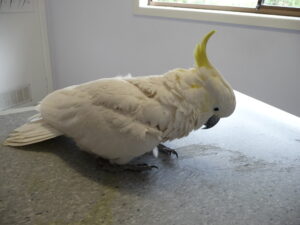Going Light and the Sick Bird Look

My Bird Looks Fluffed Up, What Should I Do?
My bird looks ‘fluffed up’ – what should I do?
Going Light and the Sick Bird Look . Birds in the wild have a natural instinct to hide their illness or injury so that they do not become a target for predation. This means that a bird may be quite ill before we are able to recognise the signs of illness. Some early signs to look for which might indicate your bird is unwell include what is commonly called the “sick bird look”. The “sick bird look” is a description that applies to birds who are showing some of the following signs or behaviours:
– feathers are fluffed up, no longer sleek along their body
– head may be tucked under a wing
– eyes closed
– birds are quiet and moving slowly or not much at all
– may be sitting on bottom of the cage
– breathing is laboured and the whole body moves when the bird breathes
This sick bird look is a non-specific sign of disease, and there are many possible underlying causes. These include reproductive disease (egg-binding, chronic egg-laying), respiratory disease (irritation, infection, pneumonia, air sacculitis), gastrointestinal disease (infection – bacteria, viruses, protozoa, worms; obstruction), nutritional deficiency or excess, septicaemia, liver or kidney disease, toxicosis (heavy metal poisoning), psittacosis, cancer and many others.
If your bird is showing some of these signs of the “sick bird look” they should be seen by a veterinarian as soon as possible, as their condition could be far more serious than it appears. In the meantime before you can get to your veterinarian, your bird should be kept in a warm, draught free environment, with good ventilation. Keep the bird in a quiet, stress free environment, and they should have water offered with good quality feed. It might be a good idea to isolate your sick bird from any others to reduce stress to the sick bird as well as protecting your healthy birds from the possibility of infectious disease.
Bird Weight Loss
“Going light” – weight loss in birds
Weight loss in birds or “going light” as it is sometimes known, can be a sign of disease, stress or malnutrition. Loss of just a small amount (even 5-10% body weight) is significant in birds, especially in small birds, as they don’t have much to lose.
Almost any illness can cause weight loss in birds. Diseases that cause weight loss include enteritis (caused by bacteria, viruses, worms or protozoa), immune suppressive diseases such as beak and feather disease or lymphoid leucosis, psittacosis, liver disease, hardware disease (which is the ingestion foreign materials that damages the gastrointestinal tract), toxicity including heavy metal poisoning and many other illnesses. Weight loss over a longer period of time may indicate more chronic diseases such as cancer or nutritional deficiencies.
Stress due to inappropriate environment (eg. overcrowding, extremes of temperature), or husbandry (eg. poor hygiene, handling, malnutrition) may also lead to weight loss.
How do I know if my bird is losing weight?
If your not sure if your bird is losing weight the simplest way to find out is to weigh your bird over a series of days or weeks and keep a record of its weight so you can track any changes occurring over time. A digital kitchen scales can be used for this purpose.
Another way to tell if your bird is in good condition is to feel the musculature on either side of the keel bone. To do this locate the bone protruding from the middle of the your birds chest (the keel bone) and run your fingers down the chest on either side of the bone. If you bird is in good condition you should be able to feel the keel bone and the muscles on either side of it. Birds in poor condition will have very little musculature covering the chest and the keel bone will be very prominent. In overweight birds it is difficult to feel the keel bone and you may only be able to feel the groove where it should be.
Diarrhoea and Changes to Droppings, Loose Droppings and Polyuria.
In normal bird droppings there are three parts: the faeces – which should formed and may be black or brown to green in colour, the urates – which are the white part and the urine – which is usually a clear liquid. Changes to these dropping in colour, consistency or amount may occur with changes to diet or disease. Monitoring your birds dropping is a good idea so you can know what is normal for your bird and so that you will can pick up on any changes early that may be a sign of disease.
If the faecal (bowel movement) part of the droppings is excessively runny your bird may have diarrhoea. Diarrhoea can be due to a number of causes such as enteritis caused by bacteria, viruses, worms, or protozoa, it could also be due to psittacosis, diet or something else. Changes to the colour of the urates from white to coloured may indicate a change in the diet (for example beetroot might turn them purple!) or disease. Yellow urates may indicate your bird has not been eating, and green urates may be a sign liver disease. Blood in the urates may change the colour from white to red or brown. Excessive urine surrounding normal faeces may indicate disease of the kidneys or heavy metal poisoning.
If these any of these changes occur you should seek advice from your veterinarian.
